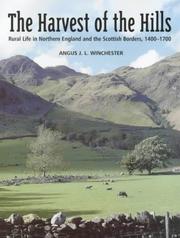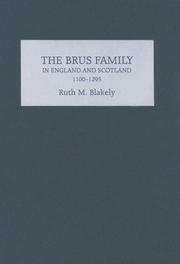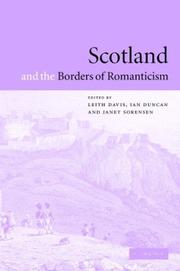| Listing 1 - 10 of 11 | << page >> |
Sort by
|
Book
Year: 1965 Publisher: London : Hutchinson,
Abstract | Keywords | Export | Availability | Bookmark
 Loading...
Loading...Choose an application
- Reference Manager
- EndNote
- RefWorks (Direct export to RefWorks)
Prehistoric peoples --- Britons. --- Scottish Borders (England and Scotland) --- Scottish Borders (Scotland) --- Antiquities. --- Antiquities.
Book
Year: 1927 Publisher: Newcastle upon Tyne : A. Reid,
Abstract | Keywords | Export | Availability | Bookmark
 Loading...
Loading...Choose an application
- Reference Manager
- EndNote
- RefWorks (Direct export to RefWorks)
Borders Region (Scotland) --- Cumberland (England) --- Northumberland (Angleterre) --- Northumberland (England) --- Scottish Borders (England and Scotland) --- History. --- Histoire.
Book
Year: 1965 Publisher: Cambridge : University press,
Abstract | Keywords | Export | Availability | Bookmark
 Loading...
Loading...Choose an application
- Reference Manager
- EndNote
- RefWorks (Direct export to RefWorks)
Romans --- Great Britain --- Scottish Borders (England and Scotland) --- Welsh Borders (England and Wales) --- Great Britain --- History --- Antiquities. --- Antiquities. --- Antiquities, Roman.

ISBN: 0585441855 9780585441856 1853312398 9781853312397 Year: 2000 Publisher: Edinburgh Edinburgh University Press
Abstract | Keywords | Export | Availability | Bookmark
 Loading...
Loading...Choose an application
- Reference Manager
- EndNote
- RefWorks (Direct export to RefWorks)
This illustrated environmental history of rural life in Northern England and the Scottish Borders in the late medieval and early modern periods explores the relationship between society and the environment - the ways in which humans responded to and used the environment in which they lived.The author uses the orders and byelaws made by manorial courts to build up a picture of how pastoral society in the Pennine, Lake District and Border hills husbanded the resources of the uplands. It offers an upland, pastoral paradigm of land use, the management of common land, and the transition from medieval to early-modern farming systems to balance the extensive literature on the agrarian history of the lowlands.The geographical scope of the book includes the Lake District, Yorkshire Dales, the Border hills, the North Pennines and the Forest of Bowland. Through a lively text and carefully selected illustrations the author captures the distinctive local culture of traditional pastoral communities in these much visited areas of Britain.
Country life --- Great Britain --- Regions & Countries - Europe --- History & Archaeology --- Rural life --- Manners and customs --- England, Northern --- Scottish Borders (England and Scotland) --- History. --- Rural conditions. --- North England --- Northern England --- Borders of England (England)
Book
ISBN: 1139198289 1108046258 Year: 2013 Publisher: Cambridge : Cambridge University Press,
Abstract | Keywords | Export | Availability | Bookmark
 Loading...
Loading...Choose an application
- Reference Manager
- EndNote
- RefWorks (Direct export to RefWorks)
The work of the poet and novelist Sir Walter Scott (1771-1832) frequently reflected his interest in Scottish history, and he is regarded as having written some of the most influential historical fiction of the nineteenth century. His literary works include the poem The Lady of the Lake and the novels Waverley and Ivanhoe. Originally published in two volumes in 1814-17, this one-volume reissue is a work of non-fiction that illuminates Border history as revealed through architecture and artefacts. Scott was not the sole author, but his substantial introduction sets the historical scene for the entries on various castles, churches and other historic structures on both sides of the border. Illustrative extracts of his poetry are also included, along with many detailed engravings of the evocative scenes and buildings described.
Castles --- Religious institutions --- History. --- Scottish Borders (England and Scotland) --- Antiquities. --- Ecclesiastical institutions --- Faith-based institutions --- Faith-based organizations --- FBOs (Faith-based organizations) --- Institutions, Ecclesiastical --- Institutions, Religious --- Religious and ecclesiastical institutions --- Religious organizations --- Associations, institutions, etc. --- Religious facilities --- Châteaux --- Feudal castles --- Architecture --- Architecture, Medieval --- Fortification --- Borders of England (England)
Book
ISBN: 1787445321 1783273976 Year: 2019 Publisher: Suffolk : Boydell & Brewer
Abstract | Keywords | Export | Availability | Bookmark
 Loading...
Loading...Choose an application
- Reference Manager
- EndNote
- RefWorks (Direct export to RefWorks)
A detailed examination of the March system - the special administrative arrangements which applied on both sides of the border - how it was applied and how it evolved as national political circumstances changed.
Nationalism --- National characteristics, Scottish --- National characteristics, English --- Borderlands --- Border-lands --- Border regions --- Frontiers --- Boundaries --- English national characteristics --- Scottish national characteristics --- Consciousness, National --- Identity, National --- National consciousness --- National identity --- International relations --- Patriotism --- Political science --- Autonomy and independence movements --- Internationalism --- Political messianism --- History --- History. --- Social aspects --- Scottish Borders (England and Scotland) --- Great Britain --- Scotland --- Borders of England (England) --- Social conditions. --- Anglo-Scottish Borderlands. --- Conflict. --- Cross-Border Interactions. --- Early Modern. --- National Differences. --- National Identity. --- Political Circumstances. --- Separation. --- Union of the Crowns.

ISBN: 1282080865 9786612080869 1846153778 184383152X Year: 2005 Publisher: Woodbridge, Suffolk ; New York : Boydell Press,
Abstract | Keywords | Export | Availability | Bookmark
 Loading...
Loading...Choose an application
- Reference Manager
- EndNote
- RefWorks (Direct export to RefWorks)
"Survey of the activities of one of the most important cross-Border families, the ancestors of Robert the Bruce"--Provided by publisher.
Normans --- Northmen --- Bruce family. --- Robert --- Bruce, Robert de, --- De Bruce, Robert, --- Robert, --- Bruce, Robert, --- Family. --- Great Britain --- Scotland --- Scottish Borders (England and Scotland) --- Caledonia --- Scotia --- Schotland --- Sŭkʻotʻŭllandŭ --- Ecosse --- Škotska --- Borders of England (England) --- History --- Kings and rulers --- Family relationships. --- Genealogy. --- Anglo-Scottish cross-Border lords. --- Annandale. --- Brus family. --- Chester. --- Cleveland. --- David I. --- English baronial families. --- Hartness. --- Henry III. --- Huntingdon estates. --- John. --- Northerners. --- Robert de Brus. --- Robert the Bruce. --- baronial troubles. --- cross-Border families. --- thirteenth century. --- twelfth century.

ISBN: 9780511484186 9780521832830 9780521180764 0511214782 9780511214783 0511216572 9780511216572 0511484186 0521832837 9780511212970 0511212976 9780511211201 0511211201 1107148936 1280516119 051131535X 0521180767 Year: 2004 Publisher: Cambridge Cambridge university press
Abstract | Keywords | Export | Availability | Bookmark
 Loading...
Loading...Choose an application
- Reference Manager
- EndNote
- RefWorks (Direct export to RefWorks)
Originally published in 2004, Scotland and the Borders of Romanticism is a collection of critical essays devoted to Scottish writing between 1745 and 1830 - a key period marking the contested divide between Scottish Enlightenment and Romanticism in British literary history. Essays in the volume, by leading scholars from Scotland, England, Canada and the USA, address a range of major figures and topics, among them Hume and the Romantic imagination, Burns's poetry, the Scottish song and ballad revivals, gender and national tradition, the prose fiction of Walter Scott and James Hogg, the national theatre of Joanna Baillie, the Romantic varieties of historicism and antiquarianism, Romantic Orientalism, and Scotland as a site of English cultural fantasies. The essays undertake a collective rethinking of the national and period categories that have structured British literary history, by examining the relations between the concepts of Enlightenment and Romanticism as well as between Scottish and English writing.
Romanticism --- Scottish literature --- Scots literature --- British literature --- Pseudo-romanticism --- Romanticism in literature --- Aesthetics --- Fiction --- Literary movements --- History and criticism. --- Scottish Borders (England and Scotland) --- Scottish Borders (Scotland) --- Scotland --- Borders Region (Scotland) --- Borders, Scot. --- Caledonia --- Scotia --- Schotland --- Sŭkʻotʻŭllandŭ --- Ecosse --- Škotska --- Great Britain --- Mairches (Scotland) --- Crìochan na h-Alba (Scotland) --- Borders of England (England) --- Intellectual life. --- In literature. --- Intellectual life --- English literature --- Inklings (Group of writers) --- Nonsense Club (Group of writers) --- Order of the Fancy (Group of writers) --- Scottish authors&delete& --- History and criticism --- Scottish authors --- Arts and Humanities --- Literature
Book
ISBN: 1108624308 1108561683 1108663826 1108472990 9781108561686 9781108472999 9781108460859 Year: 2020 Publisher: Cambridge Cambridge University Press
Abstract | Keywords | Export | Availability | Bookmark
 Loading...
Loading...Choose an application
- Reference Manager
- EndNote
- RefWorks (Direct export to RefWorks)
The three counties of England's northern borderlands have long had a reputation as an exceptional and peripheral region within the medieval kingdom, preoccupied with local turbulence as a result of the proximity of a hostile frontier with Scotland. Yet, in the fifteenth century, open war was an infrequent occurrence in a region which is much better understood by historians of fourteenth-century Anglo-Scottish conflict, or of Tudor responses to the so-called 'border reivers'. This first book-length study of England's far north in the fifteenth century addresses conflict, kinship, lordship, law, justice, and governance in this dynamic region. It traces the norms and behaviours by which local society sought to manage conflict, arguing that common law and march law were only parts of a mixed framework which included aspects of 'feud' as it is understood in a wider European context. Addressing the counties of Northumberland, Cumberland and Westmorland together, Jackson W. Armstrong transcends an east-west division in the region's historiography and challenges the prevailing understanding of conflict in late medieval England, setting the region within a wider comparative framework.
Conflict management --- Local government --- Local administration --- Township government --- Subnational governments --- Administrative and political divisions --- Decentralization in government --- Public administration --- Conflict control --- Conflict resolution --- Dispute settlement --- Management of conflict --- Managing conflict --- Management --- Negotiation --- Problem solving --- Social conflict --- Crisis management --- History --- England, Northern --- Scottish Borders (England and Scotland) --- Scotland --- England --- Great Britain --- Borders of England (England) --- North England --- Northern England --- Caledonia --- Scotia --- Schotland --- Sŭkʻotʻŭllandŭ --- Ecosse --- Škotska --- Angleterre --- Anglii︠a︡ --- Inghilterra --- Engeland --- Inglaterra --- Anglija --- England and Wales --- History, Military. --- History, Military --- Foreign relations --- Politics and government
Book
ISBN: 1280488700 9786613583932 1846158958 0861933079 Year: 2010 Publisher: [London, England] : Suffolk, U.K. ; Rochester, N.Y. : Royal Historical Society ; Boydell Press,
Abstract | Keywords | Export | Availability | Bookmark
 Loading...
Loading...Choose an application
- Reference Manager
- EndNote
- RefWorks (Direct export to RefWorks)
Explores the policy of pacification after the accession of James I to the throne of England and his utilization of the largely co-operative Borders elite.
Scottish Borders (England and Scotland) --- Great Britain --- Scotland --- England --- History --- Foreign relations --- Caledonia --- Scotia --- Schotland --- Sŭkʻotʻŭllandŭ --- Ecosse --- Škotska --- Borders of England (England) --- Angleterre --- Anglii︠a︡ --- Inghilterra --- Engeland --- Inglaterra --- Anglija --- England and Wales --- HISTORY / Modern / General. --- Administrative Activity. --- Border Region. --- Border region. --- Early Modern Scotland. --- England. --- Feuding. --- Governance. --- Governmental Processes. --- Great Britain. --- James I and VI. --- James VI. --- Kinship. --- National State. --- Peebles. --- Political History. --- Power Structures. --- Scotland. --- Scottish Borders. --- Scottish Middle March. --- Selkirk. --- Shires of Roxburgh. --- State Formation. --- Transformation. --- Union. --- alliance. --- early modern Scotland. --- governance. --- governmental processes. --- judicial processes. --- kinship. --- power structures.
| Listing 1 - 10 of 11 | << page >> |
Sort by
|

 Search
Search Feedback
Feedback About UniCat
About UniCat  Help
Help News
News